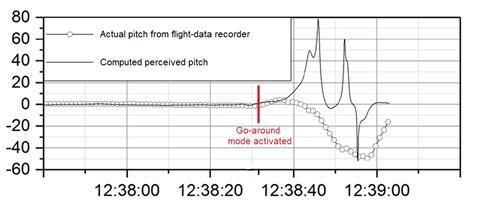Investigators have alluded to the possibility that an Atlas Air Boeing 767-300 freighter pilot experienced somatogravic illusion before the aircraft entered a fatal dive on approach to Houston.
The aircraft had been descending through cloud at 6,000ft when its go-around mode activated and its engine thrust increased, causing the aircraft to accelerate into a shallow climb.
US National Transportation Safety Board documentation states that the go-around mode was activated “using one of the go-around buttons on the throttle quadrant” – although it does not indicate why the button was pressed.
“There was no mention of initiating a go-around by the flight crew on the cockpit voice recorder,” says the NTSB in an aircraft performance analysis.
Cockpit-voice recordings reveal that the first officer – who was flying – remarked, “We’re stalling”, about 17s after the go-around mode activation.
But the inquiry analysis contradicts this perception. The wing’s angle-of-attack was below -15°, it points out, while the aircraft’s airspeed was above 250kt.
“This is well below the [aircraft’s] wing stall angle-of-attack,” the analysis adds.

It flags the possibility that the first officer misperceived the aircraft’s acceleration as a sharp pitch upwards – a phenomenon known as somatogravic illusion, which occurs when visual cues to differentiate the two sensations are absent.
The analysis compares the 767’s actual pitch with the apparent pitch which the first officer might have experienced according to a mathematical calculation.
It indicates that, although the control column was pushed forward and the aircraft transitioned from the shallow climb to a steep dive, the pilot could have erroneously perceived that the jet was pitching upwards at an alarming 40° and even momentarily at 60-80°.
“If the change is interpreted as the result of a climb, the pilot will input nose-down elevator in response,” says the analysis.
“For this reason, it is important that pilots develop an effective instrument scan in [instrument meteorological conditions].”
Flight-data recorder information showed an elevator split emerged as the aircraft entered the dive, with the captain applying nose-up input.
This split continued for several second but ceased about 1s after the aircraft would have broken out of the 3,500ft cloud layer – at which point both pilots would have been able to see that the jet was diving steeply.
Both subsequently pulled on the control columns but were not able to recover the aircraft sufficiently to avoid its impact with Trinity Bay. None of the three occupants survived the 23 February crash.


























